Polyurea for Blast and Impact Protection: A Review
Abstract
:1. Introduction
- The ratio of hard and soft segments of polyurea should be reasonably optimized to ensure that the material provides high strength while being able to resist large deformation, inhibit structural damage and reduce fragmentation rate.
- It is essential for polyurea to be thermally stable; therefore, the material can maintain high mechanical properties in response to high temperatures coupled with impact loading.
- The material should exhibit a high elastic modulus and long plastic stage when subjected to medium or high strain rate loading, as well as a high loss modulus and storage modulus, thus fully dissipating energy in the deformation process.
- The un-relaxed and relaxed modulus of the material should be increased as much as possible to absorb and dissipate wider frequency bands of loading.
2. Materials Optimization
2.1. Optimization of Polyurea
2.2. MD Simulation of Polyurea
2.3. Incorporation of Reinforcing Materials
3. Protection Mechanisms
3.1. Soft and Hard Segment Rearrangement, Crystallization and Hardening
3.2. Viscous Dissipation within the Material and Strain Rate Effects
3.3. Impedance Mismatch between Substrate and Polyurea
4. Research and Application of Polyurea in Blast/Impact Protection
4.1. Protection of Civil Engineering Structures
4.2. Protection of Metal Structures
4.3. Protective Applications for Composite Materials
5. Conclusions and Outlook
- Extremely high demands are placed on the spraying process, and in the event of uneven mixing, the completed sprayed surface needs to be completely removed.
- The repair of damaged coatings is quite difficult and requires cutting and surface treatment of the original coating.
- The cost of spraying polyurea (material loss, equipment cost, etc.) is high, and the current spraying technology is suitable for continuous operation of a large area, whereas for small-area spraying, the loss of raw materials is relatively large for each spraying.
Author Contributions
Funding
Informed Consent Statement
Data Availability Statement
Acknowledgments
Conflicts of Interest
References
- Iqbal, N.; Tripathi, M.; Parthasarathy, S.; Kumar, D.; Roy, P.K. Tuning the properties of segmented polyurea by regulating soft-segment length. J. Appl. Polym. Sci. 2018, 135, 46284. [Google Scholar] [CrossRef]
- Li, T.; Zhang, C.; Xie, Z.; Xu, J.; Guo, B.-H. A multi-scale investigation on effects of hydrogen bonding on micro-structure and macro-properties in a polyurea. Polymer 2018, 145, 261–271. [Google Scholar] [CrossRef]
- Sophia, D.; Sophia, S.; George, Y. Quasi-static and dynamic characterization of polyurea microspheres reinforced polyurea matrix composite. Mater. Today Commun. 2020, 25, 101464. [Google Scholar]
- Tripathi, M.; Parthasarathy, S.; Roy, P.K. Spray processable polyurea formulations: Effect of chain extender length on material properties of polyurea coatings. J. Appl. Polym. Sci. 2020, 137, 48573. [Google Scholar] [CrossRef]
- Jia, Z.Z.; Amirkhizi, A.V.; Nantasetphong, W.; Nemat-Nasser, S. Experimentally-based relaxation modulus of polyurea and its composites. Mech. Time-Depend. Mater. 2016, 20, 155–174. [Google Scholar] [CrossRef] [Green Version]
- Temizkan, E.; Eroglu, G.; Ergun, A.; Deligoz, H. Preparation, characterization, and influence of polyurea coatings on their layered composite materials based on flexible rebonded polyurethane. Polym. Eng. Sci. 2021, 61, 1392–1404. [Google Scholar] [CrossRef]
- Huang, W. Spray Polyurea Elastomer Technology; Chemical Industry Press: Beijing, China, 2005. [Google Scholar]
- Qiao, J.; Amirkhizi, A.V.; Schaaf, K.; Nemat-Nasser, S.; Wu, G. Dynamic mechanical and ultrasonic properties of polyurea. Mech. Mater. 2011, 43, 598–607. [Google Scholar] [CrossRef]
- Tuerp, D.; Bruchmann, B. Dendritic polyurea polymers. Macromol. Rapid Commun. 2015, 36, 138–150. [Google Scholar] [CrossRef]
- Che, K.; Ping, L.; Wan, F.; Ma, M. Investigations on aging behavior and mechanism of polyurea coating in marine atmosphere. Materials 2019, 12, 3636. [Google Scholar] [CrossRef] [Green Version]
- Eastmond, T.; Hu, J.; Alizadeh, V.; Hrubiak, R.; Oswald, J.; Amirkhizi, A.; Peralta, P. Probing high-pressure structural evolution in polyurea with in situ energy-dispersive x-ray diffraction and molecular dynamics simulations. Macromolecules 2021, 54, 597–608. [Google Scholar] [CrossRef]
- Primeaux, D.J. 100% solids aliphatic spray polyurea elastomer systems. J. Elastomers Plast. 1992, 24, 323–336. [Google Scholar] [CrossRef]
- Lyu, P.; Fang, Z.; Wang, X.; Huang, W.; Zhang, R.; Sang, Y.; Sun, P. Explosion test and numerical simulation of coated reinforced concrete slab based on blast mitigation polyurea coating performance. Materials 2022, 15, 2607. [Google Scholar] [CrossRef] [PubMed]
- Zhang, P.; Wang, Z.; Zhao, P.; Zhang, L.; Jin, X.C.; Xu, Y. Experimental investigation on ballistic resistance of polyurea coated steel plates subjected to fragment impact. Thin-Walled Struct. 2019, 144, 106342. [Google Scholar] [CrossRef]
- Wu, G.; Wang, X.; Ji, C.; Liu, Q.; Gao, Z.; Zhang, K.; Zhao, C. Experimental and numerical simulation study on polyurea-coated fuel tank subjected to combined action of blast shock waves and fragments. Thin-Walled Struct. 2021, 169, 108436. [Google Scholar] [CrossRef]
- Gang, W.; Xin, W.; Chong, J.; Zhenru, G.; Tao, J.; Changxiao, Z.; Yujun, L. Anti-blast properties of 6063-t5 aluminum alloy circular tubes coated with polyurea elastomer: Experiments and numerical simulations. Thin-Walled Struct. 2021, 164, 107842. [Google Scholar]
- Sanchez-Ferrer, A.; Rogez, D.; Martinoty, P. Influence of the degree of polymerisation and of the architecture on the elastic properties of new polyurea elastomers. RSC Adv. 2015, 5, 6758–6770. [Google Scholar] [CrossRef]
- Iqbal, N.; Tripathi, M.; Parthasarathy, S.; Kumar, D.; Roy, P.K. Polyurea spray coatings: Tailoring material properties through chemical crosslinking. Prog. Org. Coat. 2018, 123, 201–208. [Google Scholar] [CrossRef]
- Mott, P.; Giller, C.; Fragiadakis, D.; Rosenberg, D.; Roland, C. Deformation of polyurea: Where does the energy go? Polymer 2016, 105, 227–233. [Google Scholar] [CrossRef]
- Hsieh, A.J.; Veysset, D.; Miranda, D.F.; Kooi, S.E.; Runt, J.; Nelson, K.A. Molecular influence in the glass/polymer interface design: The role of segmental dynamics. Polymer 2018, 146, 222–229. [Google Scholar] [CrossRef]
- Hsieh, A.J.; Champagne, V.K.; Kooi, S.E. Interface-by-design in zirconia-polyurea matrix hybrid composites. Polymer 2020, 209, 122939. [Google Scholar] [CrossRef]
- Barczewski, M.; Biedrzycka, K.; Mysiukiewicz, O.; Matykiewicz, D.; Andrzejewski, J.; Klozinski, A.; Szostak, M. Milled basalt fibers as reinforcement for polyurea composite spray coatings with improved thermomechanical stability and mechanical performance. Polimery 2020, 65, 184–195. [Google Scholar] [CrossRef]
- Barczewski, M.; Biedrzycka, K.; Szostak, M.; Klozinski, A.; Anisko, J.; Matykiewicz, D.; Andrzejewski, J.; Hahn, J.; Wiernicki, J. Spray-formed polyurea composites filled with basalt powder as inorganic waste filler. Plast. Rubber Compos. 2021, 9, 276–284. [Google Scholar] [CrossRef]
- Gong, C.C.; Chen, Y.; Li, T.; Liu, Z.L.; Zhuang, Z.; Guo, B.H.; Wang, H.Y.; Dai, L.H. Free volume based nonlinear viscoelastic model for polyurea over a wide range of strain rates and temperatures. Mech. Mater. 2021, 152, 103650. [Google Scholar] [CrossRef]
- Rahimzadeh, T.; Arruda, E.M.; Thouless, M.D. Design of armor for protection against blast and impact. J. Mech. Phys. Solids 2015, 85, 98–111. [Google Scholar] [CrossRef] [Green Version]
- Jiang, Y.X.; Zhang, B.Y.; Wei, J.S.; Wang, W. Study on the dynamic response of polyurea coated steel tank subjected to blast loadings. J. Loss Prev. Process Ind. 2020, 67, 104234. [Google Scholar] [CrossRef]
- Qiao, J.; Amirkhizi, A.V.; Schaaf, K.; Nemat-Nasser, S. Dynamic mechanical analysis of fly ash filled polyurea elastomer. J. Eng. Mater. Technol. 2011, 133, 011016. [Google Scholar] [CrossRef] [Green Version]
- LeBlanc, J.; Shukla, A. Response of polyurea-coated flat composite plates to underwater explosive loading. J. Compos. Mater. 2015, 49, 965–980. [Google Scholar] [CrossRef]
- LeBlanc, J.; Shillings, C.; Gauch, E.; Livolsi, F.; Shukla, A. Near field underwater explosion response of polyurea coated composite plates. Exp. Mech. 2016, 56, 569–581. [Google Scholar] [CrossRef]
- Gauch, E.; LeBlanc, J.; Shukla, A. Near field underwater explosion response of polyurea coated composite cylinders. Compos. Struct. 2018, 202, 836–852. [Google Scholar] [CrossRef]
- Pinto, M.; Shukla, A. Mitigation of pressure pulses from implosion of hollow composite cylinders. J. Compos. Mater. 2016, 50, 3709–3718. [Google Scholar] [CrossRef]
- Chen, C.; Wang, X.; Hou, H.; Cheng, Y.; Zhang, P.; Liu, J. Effect of strength matching on failure characteristics of polyurea coated thin metal plates under localized air blast loading: Experiment and numerical analysis. Thin-Walled Struct. 2020, 154, 106819. [Google Scholar] [CrossRef]
- Li, Y.Q.; Chen, C.H.; Hou, H.L.; Cheng, Y.S.; Gao, H.P.; Zhang, P.; Liu, T. The influence of spraying strategy on the dynamic response of polyurea-coated metal plates to localized air blast loading: Experimental investigations. Polymers 2019, 11, 1888. [Google Scholar] [CrossRef] [PubMed] [Green Version]
- Hou, H.; Chen, C.; Cheng, Y.; Zhang, P.; Tian, X.; Liu, T.; Wang, J. Effect of structural configuration on air blast resistance of polyurea-coated composite steel plates: Experimental studies. Mater. Des. 2019, 182, 108049. [Google Scholar] [CrossRef]
- Yuxiang, S.; Xin, W.; Chong, J.; Changxiao, Z.; Li, L.P.; Lei, M.; Kun, Z.; Tao, J. Experimental investigation on anti-penetration performance of polyurea-coated astm1045 steel plate subjected to projectile impact. Def. Technol. 2021, 17, 1496–1513. [Google Scholar]
- Zhang, L.; Wang, X.; Wang, Y.; Gu, J.; Ji, C.; Wu, G.; Cheng, L. High-hardness polyurea coated steel plates subjected to combined loadings of shock wave and fragments. Lat. Am. J. Solids Struct. 2022, 19, 2. [Google Scholar] [CrossRef]
- Mohotti, D.; Ali, M.; Ngo, T.; Lu, J.; Mendis, P. Strain rate dependent constitutive model for predicting the material behaviour of polyurea under high strain rate tensile loading. Mater. Des. 2014, 53, 830–837. [Google Scholar] [CrossRef]
- Tekalur, S.A.; Shukla, A.; Shivakumar, K. Blast resistance of polyurea based layered composite materials. Compos. Struct. 2008, 84, 271–281. [Google Scholar] [CrossRef]
- Shi, S.Q.; Liao, Y.; Peng, X.Q.; Liang, C.K.; Sun, J.H. Behavior of polyurea-woven glass fiber mesh composite reinforced rc slabs under contact explosion. Int. J. Impact Eng. 2019, 132, 103335. [Google Scholar] [CrossRef]
- Liu, Y.; Wang, P.; Jin, F.N.; He, H.G.; Zhou, Y.Z.; Chen, H.L.; Zhou, J.N.; Wang, B.; Fan, H.L. Blast responses of polyurea-coated concrete arches. Arch. Civ. Mech. Eng. 2021, 21, 30. [Google Scholar] [CrossRef]
- Guo, H.; Guo, W.; Amirkhizi, A.V.; Zou, R.; Yuan, K. Experimental investigation and modeling of mechanical behaviors of polyurea over wide ranges of strain rates and temperatures. Polym. Test. 2016, 53, 234–244. [Google Scholar] [CrossRef] [Green Version]
- Wu, Y.-C.M.; Hu, W.; Sun, Y.; Veysset, D.; Kooi, S.E.; Nelson, K.A.; Swager, T.M.; Hsieh, A.J. Unraveling the high strain-rate dynamic stiffening in select model polyurethanes − the role of intermolecular hydrogen bonding. Polymer 2019, 168, 218–227. [Google Scholar] [CrossRef]
- Cheng, J.; Liu, Z.L.; Luo, C.C.; Li, T.; Li, Z.J.; Kang, Y.; Zhuang, Z. Revealing the high-frequency attenuation mechanism of polyurea-matrix composites. Acta Mech. Sin. 2020, 36, 130–142. [Google Scholar] [CrossRef]
- Jian, C.; Yanchao, S.; Xihong, Z.; Weibo, H.; Mingliang, M. Experimental study on the tension and puncture behavior of spray polyurea at high strain rates. Polym. Test. 2020, 93, 106863. [Google Scholar]
- Tripathi, M.; Parthasarathy, S.; Kumar, D.; Chandel, P.; Sharma, P.; Roy, P.K. Strain rate sensitivity of polyurea coatings: Viscous and elastic contributions. Polym. Test. 2020, 86, 106488. [Google Scholar] [CrossRef]
- Shahi, V.; Alizadeh, V.; Amirkhizi, A.V. Thermo-mechanical characterization of polyurea variants. Mech. Time-Depend. Mater. 2020, 23, 447–471. [Google Scholar] [CrossRef]
- Holzworth, K.; Jia, Z.; Amirkhizi, A.V.; Qiao, J.; Nemat-Nasser, S. Effect of isocyanate content on thermal and mechanical properties of polyurea. Polymer 2013, 54, 3079–3085. [Google Scholar] [CrossRef]
- Guan, J.; Sacks, M.S.; Beckman, E.J.; Wagner, W.R. Synthesis, characterization, and cytocompatibility of elastomeric, biodegradable poly(ester-urethane)ureas based on poly(caprolactone) and putrescine. J. Biomed. Mater. Res. 2010, 61, 493–503. [Google Scholar] [CrossRef]
- Zhen, X.; Chengzhen, C.; Hui, X.; Tao, X.; Shaobing, Z. Multifunctional thermoplastic polyurea based on the synergy of dynamic disulfide bonds and hydrogen bond cross-links. ACS Appl. Mater. Interfaces 2020, 13, 1463–1473. [Google Scholar]
- Iqbal, N.; Tripathi, M.; Parthasarathy, S.; Kumar, D.; Roy, P.K. Aromatic versus aliphatic: Hydrogen bonding pattern in chain-extended high-performance polyurea. ChemistrySelect 2018, 3, 1976–1982. [Google Scholar] [CrossRef]
- Li, T.; Zheng, T.Z.; Guo, Z.X.; Xu, J.; Guo, B.H. A well-defined hierarchical hydrogen bonding strategy to polyureas with simultaneously improved strength and toughness. Chin. J. Polym. Sci. 2019, 37, 1257–1266. [Google Scholar] [CrossRef]
- Chen, X.; Zawaski, C.E.; Spiering, G.A.; Liu, B.E.; Orsino, C.M.; Moore, R.B.; Williams, C.B.; Long, T.E. Quadruple hydrogen bonding supramolecular elastomers for melt extrusion additive manufacturing. ACS Appl. Mater. Interfaces 2020, 12, 32006–32016. [Google Scholar] [CrossRef] [PubMed]
- Huang, W.; Yang, Y.; Li, H.; Lyu, P.; Zhang, R. Characterization and damping property of a modified polyurea material. DEStech Trans. Mater. Sci. Eng. 2017. [Google Scholar] [CrossRef] [Green Version]
- Iqbal, N.; Sharma, P.; Kumar, D.; Roy, P. Protective polyurea coatings for enhanced blast survivability of concrete. Constr. Build. Mater. 2018, 175, 682–690. [Google Scholar] [CrossRef]
- Iqbal, N.; Kumar, D.; Roy, P.K. Understanding the role of isocyanate dilution toward spraying of polyurea. J. Appl. Polym. Sci. 2018, 135, 45869. [Google Scholar] [CrossRef]
- Iqbal, N.; Kumar, D.; Roy, P.K. Emergence of time-dependent material properties in chain extended polyureas. J. Appl. Polym. Sci. 2018, 135, 46730. [Google Scholar] [CrossRef]
- Heyden, S.; Ortiz, M.; Fortunelli, A. All-atom molecular dynamics simulations of multiphase segregated polyurea under quasistatic, adiabatic, uniaxial compression. Polymer 2016, 106, 100–108. [Google Scholar]
- Agrawal, V.; Arya, G.; Oswald, J. Simultaneous iterative boltzmann inversion for coarse-graining of polyurea. Macromolecules 2014, 47, 3378–3389. [Google Scholar]
- Goswami, A.; Das Adhikary, S. Retrofitting materials for enhanced blast performance of structures: Recent advancement and challenges ahead. Constr. Build. Mater. 2019, 204, 224–243. [Google Scholar] [CrossRef]
- Agrawal, V.; Holzworth, K.; Nantasetphong, W.; Amirkhizi, A.V.; Oswald, J.; Nemat-Nasser, S. Prediction of viscoelastic properties with coarse-grained molecular dynamics and experimental validation for a benchmark polyurea system. J. Polym. Sci. Part B Polym. Phys. 2016, 54, 797–810. [Google Scholar]
- Liu, M.H.; Oswald, J. Coarse-grained molecular modeling of the microphase structure of polyurea elastomer. Polymer 2019, 176, 1–10. [Google Scholar]
- Yao, K.; Liu, Z.; Li, T.; Guo, B.; Zhuang, Z. Mesoscale structure-based investigation of polyurea dynamic modulus and shock-wave dissipation. Polymer 2020, 202, 122741. [Google Scholar] [CrossRef]
- Grujicic, M.; Snipes, J.S.; Ramaswami, S.; Yavari, R.; Runt, J.; Tarter, J.; Dillon, G. Coarse-grained molecular-level analysis of polyurea properties and shock-mitigation potential. J. Mater. Eng. Perform. 2013, 22, 1964–1981. [Google Scholar] [CrossRef]
- Manav, M.; Ortiz, M. Molecular dynamics study of the shock response of polyurea. Polymer 2021, 21, 123109. [Google Scholar] [CrossRef]
- Hossein, J.M.; Hanif, K. Performance of polyurea formulations against impact loads: A molecular dynamics and mechanical simulation approach. J. Appl. Polym. Sci. 2020, 138, 50309. [Google Scholar]
- Liu, Y.T.; Zhu, D.; Sun, J.W.; Wu, Y.M.; Gao, C.H. A new cross-linked system of silicone rubber based on silicone-polyurea block copolymer. Polym. Adv. Technol. 2018, 29, 2064–2071. [Google Scholar] [CrossRef]
- Petre, R.; Zecheru, T.; Ginghina, R. Dynamic tests on polyurea-based hybrid composites for ballistic protection. Mater. Plast. 2021, 58, 41–47. [Google Scholar] [CrossRef]
- Liu, Q.; Chen, P.; Guo, Y.; Su, J.; Han, L.; Arab, A.; Yuan, J. Mechanical behavior and failure mechanism of polyurea nanocomposites under quasi-static and dynamic compressive loading. Def. Technol. 2021, 17, 495–504. [Google Scholar] [CrossRef]
- Petre, R.; Zecheru, T.; Petrea, N.; Ginghina, R.; Sandu, S.; Muresan, M.; Matache, L.C.; Sava, A.C.; Neatu, F. Synthesis and mechanical properties of polyurea-based hybrid composites for ballistic individual protection. Mater. Plast. 2018, 55, 315–319. [Google Scholar] [CrossRef]
- Kalmagambetova, A.S.; Bogoyavlenskaya, T.A. Effect of the modification of polyurea by glass-microspheres on its performance. Glass Ceram. 2020, 77, 19–21. [Google Scholar] [CrossRef]
- Nantasetphong, W.; Amirkhizi, A.V.; Jia, Z.; Nemat-Nasser, S. Dynamic properties of polyurea-milled glass composites part II: Micromechanical modeling. Mech. Mater. 2016, 98, 111–119. [Google Scholar] [CrossRef]
- Nantasetphong, W.; Jia, Z.Z.; Amirkhizi, A.V.; Nemat-Nasser, S. Dynamic properties of polyurea-milled glass composites part I: Experimental characterization. Mech. Mater. 2016, 98, 142–153. [Google Scholar] [CrossRef]
- Song, J.H.; Lee, E.T.; Eun, H.C. A study on the improvement of structural performance by glass fiber-reinforced polyurea (gfrpu) reinforcement. Adv. Civ. Eng. 2019, 2019, 2818219. [Google Scholar] [CrossRef]
- Oddy, A.; Lebar, A.; Aguiar, R.; Petel, O. Spall Strength Measurement of Spray Polyurea and Alumina Reinforced Spray Polyurea Composite. In Shock Compression of Condensed Matter-2019: Proceedings of the Conference of the American Physical Society Topical Group on Shock Compression of Condensed Matter; AIP Publishing LLC: Melville, NY, USA, 2020. [Google Scholar]
- Allard, T.L.; He, L. Molecular resiliency and chemical bond richness of interfacial epoxy-polyurea matrix linked to characteristics of glass transition temperature. Mater. Today Commun. 2019, 20, 100560. [Google Scholar]
- Greco, A.; Maffezzoli, A.; Casciaro, G.; Caretto, F. Mechanical properties of basalt fibers and their adhesion to polypropylene matrices. Compos. Part B Eng. 2014, 67, 233–238. [Google Scholar] [CrossRef]
- Zhou, J.-N.; Chen, X.-S.; Zhou, Y.-Z.; Wang, W.-Y.; Wang, P.; Kong, X.-L.; Xu, Y.; Geng, H.-S.; Jin, F.-N. Blast responses of polyurea retrofitted utility tunnel reinforced with basalt fibre reinforced polymer bars. Def. Technol. 2021, 18, 755–771. [Google Scholar] [CrossRef]
- Zhou, H.; Attard, T.L.; Dhiradhamvit, K.; Wang, Y.; Erdman, D. Crashworthiness characteristics of a carbon fiber reinforced dual-phase epoxy–polyurea hybrid matrix composite. Compos. Part B 2015, 71, 17–27. [Google Scholar] [CrossRef] [Green Version]
- Attard, T.L.; He, L.; Zhou, H.Y. Improving damping property of carbon-fiber reinforced epoxy composite through novel hybrid epoxy-polyurea interfacial reaction. Compos. Part B Eng. 2019, 164, 720–731. [Google Scholar] [CrossRef]
- Kirmani, M.H.; Arias-Monje, P.J.; Kumar, S. High interfacial shear strain in polyurea-carbon nanotube composite sheets. ACS Appl. Nano Mater. 2019, 2, 6849–6857. [Google Scholar] [CrossRef]
- Tse, K.M.; Tan, L.B.; Bin Sapingi, M.A.; Franklyn, M.; Lee, P.V.S.; Tan, V.B.C.; Lee, H.P. The role of a composite polycarbonate-aerogel face shield in protecting the human brain from blast-induced injury: A fluid-structure interaction (fsi) study. J. Sandw. Struct. Mater. 2019, 21, 2484–2511. [Google Scholar] [CrossRef]
- Song, J.H. Pairing effect and tensile properties of laminated high-performance hybrid composites prepared using carbon/glass and carbon/aramid fibers. Compos. Part B Eng. 2015, 79, 61–66. [Google Scholar] [CrossRef]
- Chin, D.C.H.; Palaniandy, K.; Hia, I.L.; Pasbakhsh, P. High performance aliphatic polyurea films reinforced using nonfunctionalized multiwalled carbon nanotubes. Polym. Compos. 2020, 41, 1036–1044. [Google Scholar] [CrossRef]
- Sun, Z.; Hu, X.; Chen, H. Effects of aramid-fibre toughening on interfacial fracture toughness of epoxy adhesive joint between carbon-fibre face sheet and aluminium substrate. Int. J. Adhes. Adhes. 2014, 48, 288–294. [Google Scholar] [CrossRef]
- Zhou, H.Y.; Attard, T.L. Rehabilitation and strength sustainability of fatigue damaged concrete-encased steel flexural members using a newly developed polymeric carbon-fiber composite. Compos. Part B Eng. 2013, 45, 1091–1103. [Google Scholar] [CrossRef]
- Petre, R.; Zecheru, T.; Petrea, N.; Ginghina, R.; Bugean, I. Polyurea-based hybrid composites for cbrn protection. Mater. Plast. 2019, 56, 715–720. [Google Scholar] [CrossRef]
- Qiao, J.; Wu, Y.D.; Li, L.Q. Effect of filler content on the stress relaxation behavior of fly ash/polyurea composites. Polym. Test. 2020, 81, 106168. [Google Scholar] [CrossRef]
- Mokeev, M.V.; Ostanin, S.A.; Saprykina, N.N.; Zuev, V.V. Microphase structure of polyurethane-polyurea copolymers as revealed by solid-state nmr: Effect of molecular architecture. Polymer 2018, 150, 72–83. [Google Scholar] [CrossRef]
- Sun, Y.C.; Wu, Y.C.M.; Veysset, D.; Kooi, S.E.; Hu, W.G.; Swager, T.M.; Nelson, K.A.; Hsieh, A.J. Molecular dependencies of dynamic stiffening and strengthening through high strain rate microparticle impact of polyurethane and polyurea elastomers. Appl. Phys. Lett. 2019, 115, 093701. [Google Scholar] [CrossRef] [Green Version]
- Liu, Q.; Chen, P.; Zhang, Y.; Li, Z. Compressive behavior and constitutive model of polyurea at high strain rates and high temperatures. Mater. Today Commun. 2020, 22, 100834. [Google Scholar] [CrossRef]
- Akl, W.; Ali, M.; Aldraihem, O.; Baz, A. Dynamic behavior of polyurea composites subjected to high strain rate loading. Finite Elem. Anal. Des. 2021, 186, 103501. [Google Scholar] [CrossRef]
- Stergiou, T.; Baxevanakis, K.P.; Roy, A.; Sazhenkov, N.A.; Sh. Nikhamkin, M.; Silberschmidt, V.V. Impact of polyurea-coated metallic targets: Computational framework. Compos. Struct. 2021, 267, 113893. [Google Scholar] [CrossRef]
- Zheng, T.; Zhang, Y.; Shi, J.; Xu, J.; Guo, B. Revealing the role of hydrogen bonding in polyurea with multiscale simulations. Mol. Simul. 2021, 47, 1258–1272. [Google Scholar] [CrossRef]
- Liu, Q.; Wang, C.J.; Zhang, Y.L.; Chen, P.W.; Su, J.J.; Zhang, F. Experimental study on thermomechanical behaviour of polyurea under dynamic compressive loading. J. Phys. Conf. Ser. 2020, 1507, 032006. [Google Scholar] [CrossRef]
- Roland, C.M.; Fragiadakis, D.; Gamache, R.M.; Casalini, R. Factors influencing the ballistic impact resistance of elastomer-coated metal substrates. Philos. Mag. 2013, 93, 468–477. [Google Scholar] [CrossRef]
- Giller, C.B.; Gamache, R.M.; Wahl, K.J.; Saab, A.P.; Roland, C.M. Coating/substrate interaction in elastomer-steel bilayer armor. J. Compos. Mater. 2016, 50, 2853–2859. [Google Scholar] [CrossRef]
- Ransom, T.C.; Ahart, M.; Hemley, R.J.; Roland, C.M. Vitrification and density scaling of polyurea at pressures up to 6 gpa. Macromolecules 2017, 50, 8274–8278. [Google Scholar] [CrossRef]
- Gamache, R.M.; Giller, C.B.; Montella, G.; Fragiadakis, D.; Roland, C.M. Elastomer-metal laminate armor. Mater. Des. 2016, 111, 362–368. [Google Scholar] [CrossRef] [Green Version]
- Matos, H.; Shukla, A. Mitigation of implosion energy from aluminum structures. Int. J. Solids Struct. 2016, 100, 566–574. [Google Scholar] [CrossRef]
- Rotariu, A.; Bucur, F.; Toader, G.; Lupoae, M.; Sava, A.C.; Somoiag, P.; Matei, M.C. Experimental study on polyurea coating effects on deformation of metallic plates subjected to air blast loads. Mater. Plast. 2016, 53, 670–674. [Google Scholar]
- Remennikov, A.; Ngo, T.; Mohotti, D.; Uy, B.; Netherton, M. Experimental investigation and simplified modeling of response of steel plates subjected to close-in blast loading from spherical liquid explosive charges. Int. J. Impact Eng. 2017, 105, 78–89. [Google Scholar] [CrossRef] [Green Version]
- Bucur, F.; Trana, E.; Rotariu, A. Numerical and experimental study on the locally blast loaded polyurea coated steel plates. Mater. Plast. 2019, 56, 492–499. [Google Scholar] [CrossRef]
- El-Sisi, A.E.; Saucier, A.; Salim, H.A.; Hoemann, J.M. Experimental and numerical evaluation of reinforced concrete walls retrofit systems for blast mitigation. J. Perform. Constr. Facil. 2019, 33, 04018113. [Google Scholar] [CrossRef]
- Chen, Y.-S.; Wang, B.; Zhang, B.; Zheng, Q.; Zhou, J.-N.; Jin, F.-N.; Fan, H.-L. Polyurea coating for foamed concrete panel: An efficient way to resist explosion. Def. Technol. 2020, 16, 136–149. [Google Scholar] [CrossRef]
- Mostofi, T.M.; Sayah-Badkhor, M.; Rezasefat, M.; Ozbakkaloglu, T.; Babaei, H. Gas mixture detonation load on polyurea-coated aluminum plates. Thin-Walled Struct. 2020, 155, 106851. [Google Scholar] [CrossRef]
- Valverde-Marcos, B.; Rubio, I.; Antona-Makoshi, J.; Chawla, A.; Loya, J.A.; Rodriguez-Millan, M. Numerical analysis of eod helmet under blast load events using human head model. Appl. Sci. 2020, 10, 8227. [Google Scholar] [CrossRef]
- Song, J.H.; Lee, E.T.; Eun, H.C. A study on the strengthening performance of concrete beam by fiber-reinforced polyurea (frpu) reinforcement. Adv. Civ. Eng. 2020, 2020, 6967845. [Google Scholar] [CrossRef]
- Wang, J.G.; Ren, H.Q.; Wu, X.Y.; Cai, C.L. Blast response of polymer-retrofitted masonry unit walls. Compos. Part B Eng. 2017, 128, 174–181. [Google Scholar] [CrossRef]
- Fallon, C.; McShane, G.J. Impact mitigating capabilities of a spray-on elastomer coating applied to concrete. Int. J. Impact Eng. 2019, 128, 72–85. [Google Scholar] [CrossRef]
- Gu, M.; Ling, X.D.; Wang, H.X.; Yu, A.F.; Chen, G.X. Experimental and numerical study of polymer-retrofitted masonry walls under gas explosions. Processes 2019, 7, 863. [Google Scholar] [CrossRef] [Green Version]
- Li, Z.; Chen, L.; Fang, Q.; Chen, W.S.; Hao, H.; Zhu, R.; Zheng, K. Experimental and numerical study on cfrp strip strengthened clay brick masonry walls subjected to vented gas explosions. Int. J. Impact Eng. 2019, 129, 66–79. [Google Scholar] [CrossRef]
- Ji, L.; Wang, P.; Cai, Y.; Shang, W.; Zu, X. Blast resistance of 240 mm building wall coated with polyurea elastomer. Materials 2022, 15, 850. [Google Scholar] [CrossRef]
- Wu, J.; Liu, Z.; Yu, J.; Xu, S. Experimental and numerical investigation of normal reinforced concrete panel strengthened with polyurea under near-field explosion. J. Build. Eng. 2022, 46, 103763. [Google Scholar] [CrossRef]
- Sonoda, Y.; Tamai, H.; Ifuku, T.; Koshiishi, M. Reinforcing effect of polyurea resin coating on rc members subject to low-speed and medium-speed impact. Adv. Struct. Eng. 2022. [Google Scholar] [CrossRef]
- Li, Y.; Chen, Z.; Zhao, T.; Cao, X.; Jiang, Y.; Xiao, D.; Fang, D. An experimental study on dynamic response of polyurea coated metal plates under intense underwater impulsive loading. Int. J. Impact Eng. 2019, 133, 103361. [Google Scholar] [CrossRef]
- Jiang, Y.; Zhang, B.; Wang, L.; Wei, J.; Wang, W. Dynamic response of polyurea coated thin steel storage tank to long duration blast loadings. Thin-Walled Struct. 2021, 163, 107747. [Google Scholar] [CrossRef]
- Mohotti, D.; Ngo, T.; Raman, S.N.; Ali, M.; Mendis, P. Plastic deformation of polyurea coated composite aluminium plates subjected to low velocity impact. Mater. Des. 2014, 56, 696–713. [Google Scholar] [CrossRef]
- Jiang, Y.; Zhang, B.; Wei, J.; Wang, W. Study on the impact resistance of polyurea-steel composite plates to low velocity impact. Int. J. Impact Eng. 2019, 133, 103357. [Google Scholar] [CrossRef]
- Rijensky, O.; Rittel, D. Numerical investigation of polyurea coated aluminum plates under hydrodynamic shocks. Thin-Walled Struct. 2021, 166, 108074. [Google Scholar] [CrossRef]
- Matos, H.; Gupta, S.; Shukla, A. Structural instability and water hammer signatures from shock-initiated implosions in confining environments. Mech. Mater. 2018, 116, 169–179. [Google Scholar] [CrossRef]
- Roland, C.M.; Fragiadakis, D.; Gamache, R.M. Elastomer–steel laminate armor. Compos. Struct. 2010, 92, 1059–1064. [Google Scholar] [CrossRef]
- Dewapriya, M.A.N.; Miller, R.E. Superior dynamic penetration resistance of nanoscale multilayer polymer/metal films. J. Appl. Mech.-Trans. ASME 2020, 87, 11. [Google Scholar] [CrossRef]
- Cai, L.G.; Al-Ostaz, A.; Li, X.B.; Fowler, C.; Cheng, A.H.D.; Alkhateb, H. Protection of steel railcar tank containing liquid chlorine from high speed impact by using polyhedral oligomeric silsesquioxane-enhanced polyurea. Int. J. Impact Eng. 2015, 75, 1–10. [Google Scholar] [CrossRef] [Green Version]
- Dewapriya, M.A.N.; Miller, R.E. Molecular dynamics study of the mechanical behaviour of ultrathin polymer-metal multilayers under extreme dynamic conditions. Comput. Mater. Sci. 2020, 184, 109951. [Google Scholar] [CrossRef]
- Dewapriya, M.A.N.; Miller, R.E. Energy absorption mechanisms of nanoscopic multilayer structures under ballistic impact loading. Comput. Mater. Sci. 2021, 195, 110504. [Google Scholar] [CrossRef]
- Tran, P.; Ngo, T.D.; Ghazlan, A. Numerical modelling of hybrid elastomeric composite panels subjected to blast loadings. Compos. Struct. 2016, 153, 108–122. [Google Scholar] [CrossRef]
- Vuong, N.V.; Wickramasinghe, S.; Ghazlan, A.; Nguyen-Xuan, H.; Tran, P. Uniaxial and biaxial bioinspired interlocking composite panels subjected to dynamic loadings. Thin-Walled Struct. 2020, 157, 107023. [Google Scholar]
- Liu, Q.; Guo, B.; Chen, P.; Su, J.; Arab, A.; Ding, G.; Yan, G.; Jiang, H.; Guo, F. Investigating ballistic resistance of cfrp/polyurea composite plates subjected to ballistic impact. Thin-Walled Struct. 2021, 166, 108111. [Google Scholar] [CrossRef]
- Dewapriya, M.A.N.; Miller, R.E. Molecular dynamics study of the penetration resistance of multilayer polymer/ceramic nanocomposites under supersonic projectile impacts. Extrem. Mech. Lett. 2021, 44, 101238. [Google Scholar] [CrossRef]
- Grujicic, M.; Bell, W.C.; Pandurangan, B.; He, T. Blast-wave impact-mitigation capability of polyurea when used as helmet suspension-pad material. Mater. Des. 2010, 31, 4050–4065. [Google Scholar] [CrossRef]
- Grujicic, M.; Arakere, A.; Pandurangan, B.; Grujicic, A.; Littlestone, A.; Barsoum, R. Computational investigation of shock-mitigation efficacy of polyurea when used in a combat helmet. Multidiscip. Model. Mater. Struct. 2012, 8, 297–331. [Google Scholar] [CrossRef]
- Grujicic, M.; Ramaswami, S.; Snipes, J.S.; Dudt, P. Potential improvement in helmet blast-protection via the use of a polyurea external coating: Combined experimental/computational analyses. Proc. Inst. Mech. Eng. Part L J. Mater. Des. Appl. 2016, 234, 337–367. [Google Scholar] [CrossRef]
- Blourchian, A.; Shaik, A.M.; Huynh, N.U.; Youssef, G. Segmental evolution of ultraviolet weathered polyurea. J. Polym. Res. 2021, 28, 117. [Google Scholar] [CrossRef]

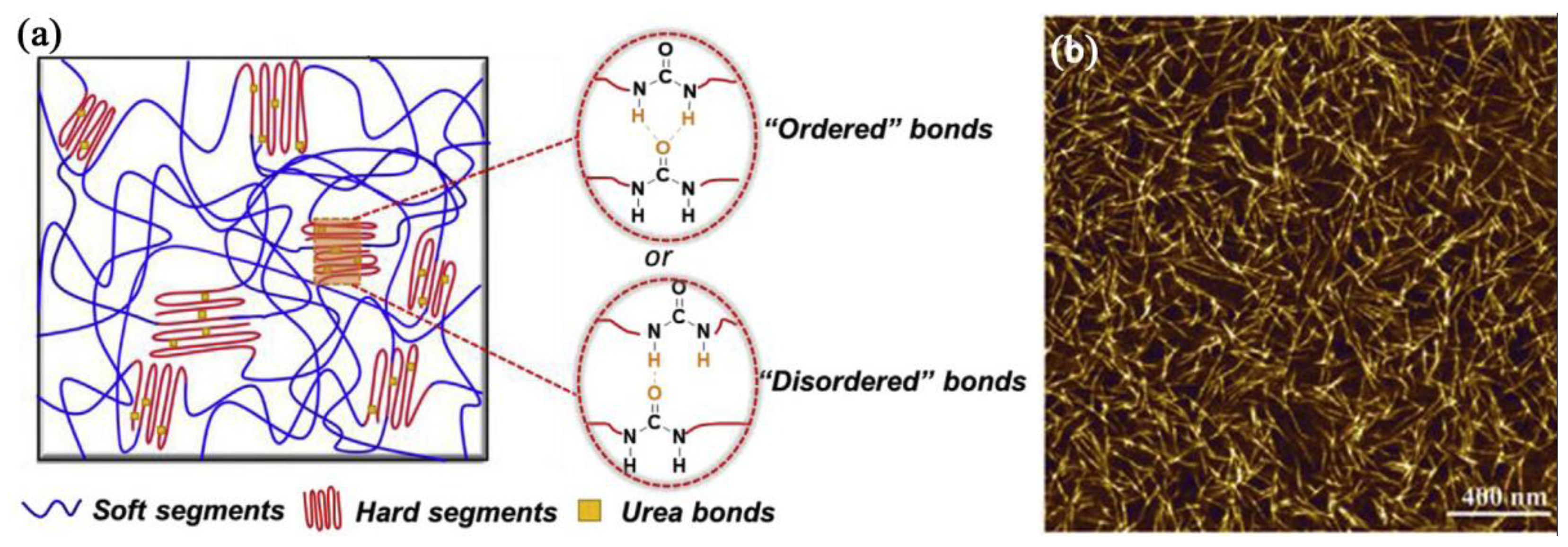
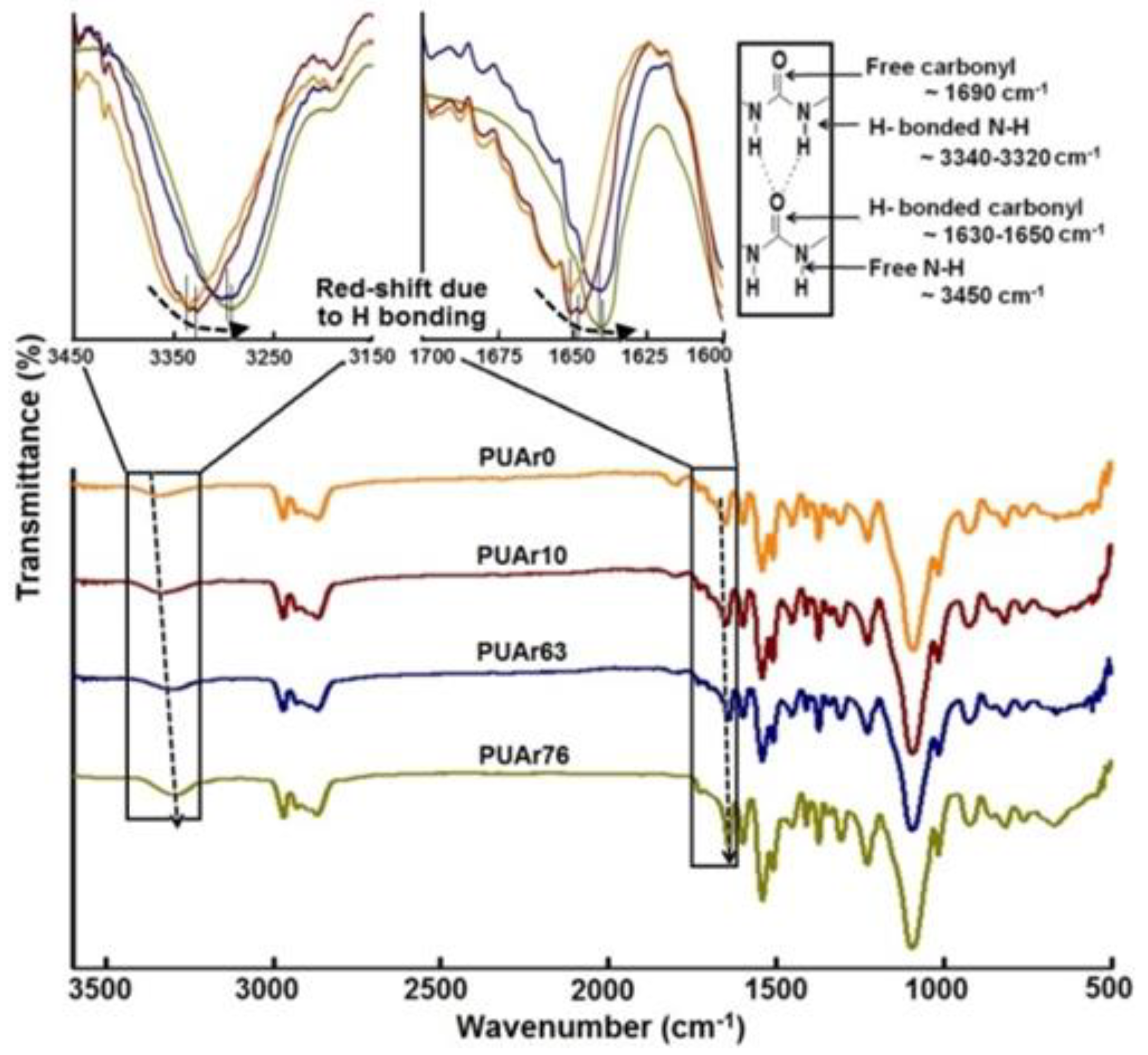




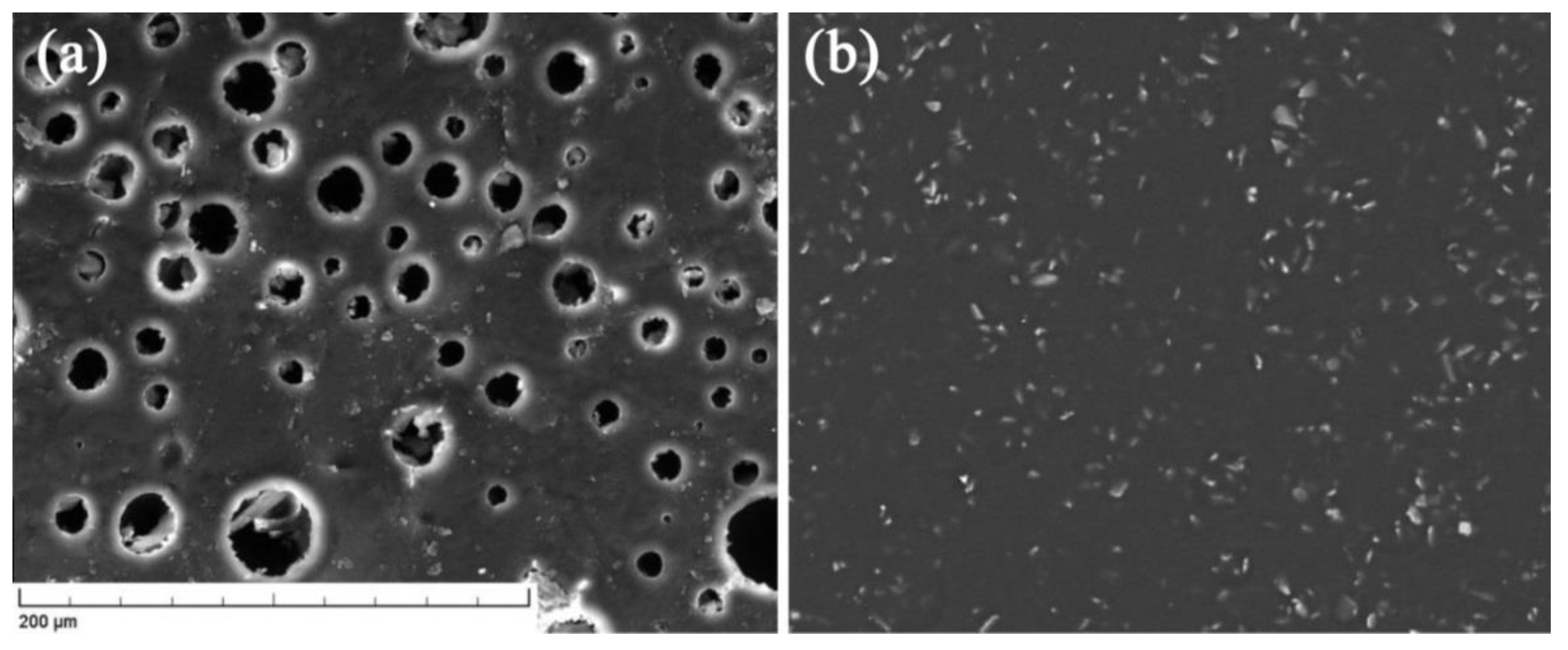

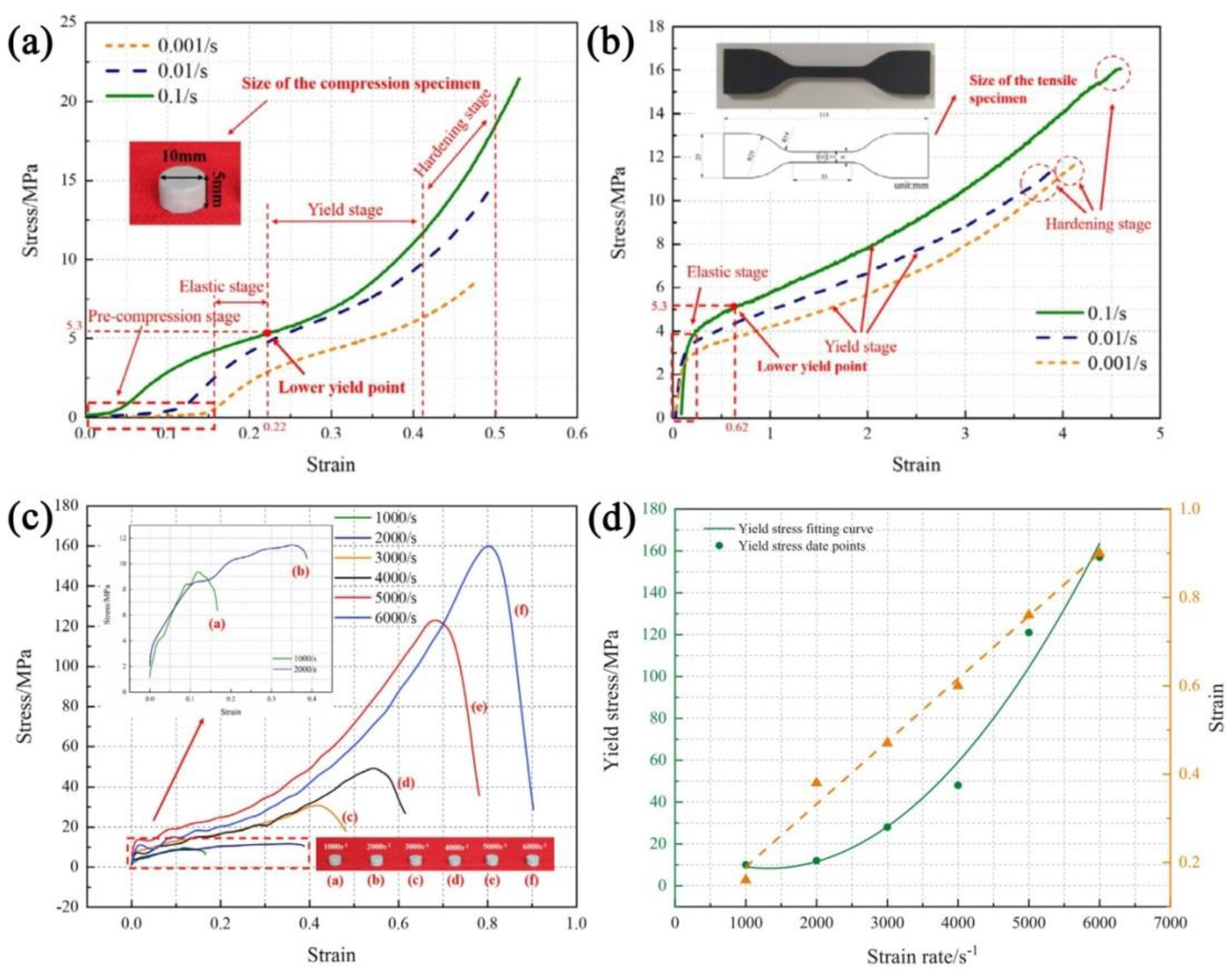




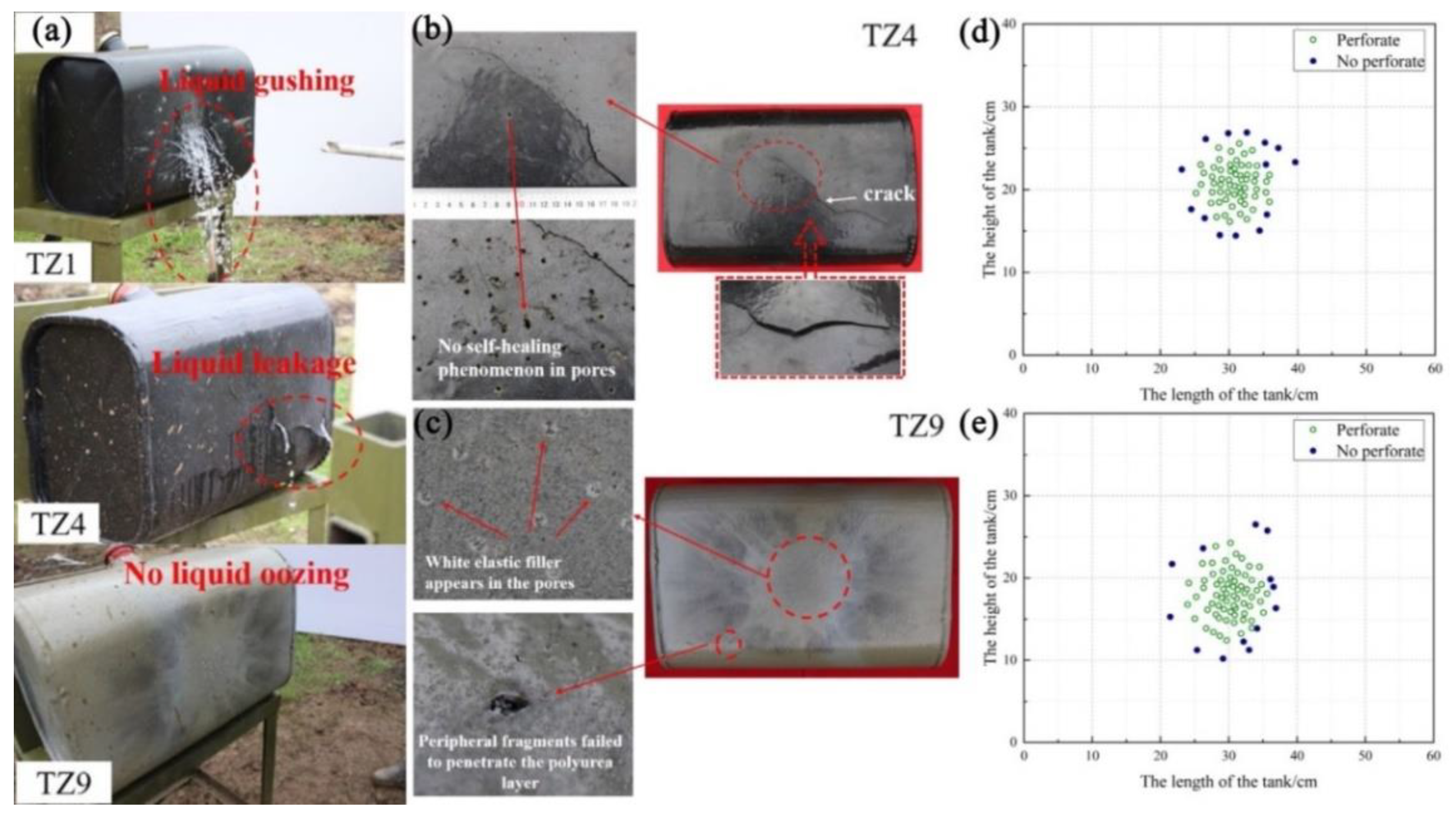

| SL. No. | Brand | Year | Mechnical Property Details | Type | Ref. | |||
|---|---|---|---|---|---|---|---|---|
| Tensile Strength (MPa) | Elongation (%) | Tear Strength (kN/m) | Shore Hardness | |||||
| 1 | EP JS | 2008 | 20.34 | 350 | 87.5 | - | aromatic | [38] |
| 2 | Dragon Shield-BC | 2014 | 11.75 | 50 | - | - | - | [28,29,30] |
| 3 | HM-VK | 2016 | 10 | 500 | - | - | - | [31] |
| 4 | Link-XS350 | 2019 | 22.39 | 163 | - | 60 ± 1 HD | - | [32,33,34] |
| 5 | SWD562 | 2019 | 16.5 | 160 | - | - | - | [39] |
| 6 | SPUA 306 | 2019 | 24 | 400 | 85 | 85–95 HA | - | [14] |
| 7 | SPUA 307 | 2019 | 25 | 45 | 81 | 65–75 HD | - | [14] |
| 8 | AMMT-53 | 2020 | 25 | 50 | 90 | 70 HD | - | [15,35,36] |
| 9 | AMMT-55 | 2020 | 35 | 300 | 115 | 65 HD | - | [15,35] |
| 10 | AP103 | 2021 | 16 | 450 | - | - | - | [16] |
| 11 | - | 2021 | 18 | 350 | 45 | 90–96 HA | - | [40] |
| 12 | Qtech T26 | 2022 | 25.4 | 451.88 | 75.5 | - | - | [13] |
Publisher’s Note: MDPI stays neutral with regard to jurisdictional claims in published maps and institutional affiliations. |
© 2022 by the authors. Licensee MDPI, Basel, Switzerland. This article is an open access article distributed under the terms and conditions of the Creative Commons Attribution (CC BY) license (https://creativecommons.org/licenses/by/4.0/).
Share and Cite
Zhang, R.; Huang, W.; Lyu, P.; Yan, S.; Wang, X.; Ju, J. Polyurea for Blast and Impact Protection: A Review. Polymers 2022, 14, 2670. https://doi.org/10.3390/polym14132670
Zhang R, Huang W, Lyu P, Yan S, Wang X, Ju J. Polyurea for Blast and Impact Protection: A Review. Polymers. 2022; 14(13):2670. https://doi.org/10.3390/polym14132670
Chicago/Turabian StyleZhang, Rui, Weibo Huang, Ping Lyu, Shuai Yan, Xu Wang, and Jiahui Ju. 2022. "Polyurea for Blast and Impact Protection: A Review" Polymers 14, no. 13: 2670. https://doi.org/10.3390/polym14132670
APA StyleZhang, R., Huang, W., Lyu, P., Yan, S., Wang, X., & Ju, J. (2022). Polyurea for Blast and Impact Protection: A Review. Polymers, 14(13), 2670. https://doi.org/10.3390/polym14132670






